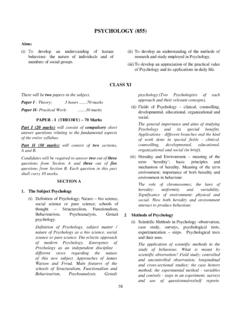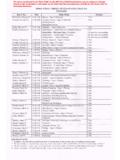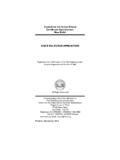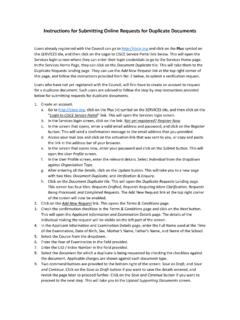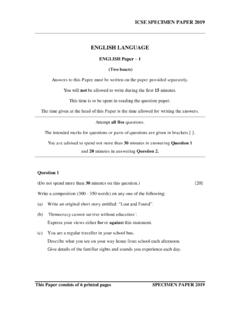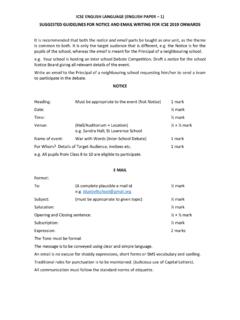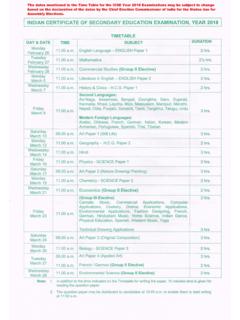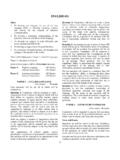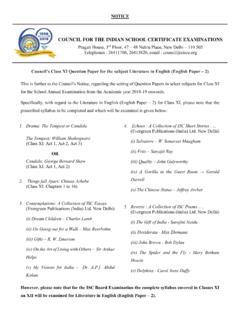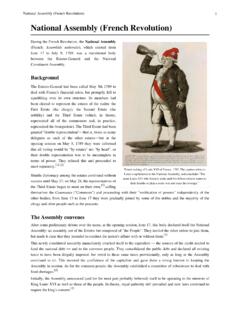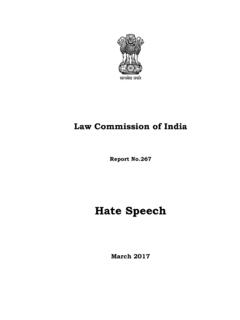Transcription of POLITICAL SCIENCE (852)
1 1 POLITICAL SCIENCE (852)CLASS XIIT here will be two papers in the subject: Paper I: Theory 3 hours ------ 80 marks Paper II: Project Work ------ 20 marks PAPER I (THEORY) 80 Marks Part I (20 marks) will consist of compulsory short answer questions, testing knowledge, application and skills relating to elementary/ fundamental aspects of the entire syllabus. Part II (60 marks) will be divided into two sections A & B. Candidates will be required to answer three questions out of five from Section A and two questions out of three from Section B. Each question in this part shall carry 12 marks. SECTION A Constitution and Government 1. Forms of Government Totalitarian and Authoritarian States, Liberal Democratic State, Unitary and Federal States, Parliamentary and Presidential forms of government.
2 Meaning and features of Totalitarian State, Authoritarian State and Liberal Democratic State. Meaning and features of Unitary and Federal States with reference to as a Unitary state, as a Federal State and India as a federal state with subsidiary unitary features, comparison between unitary and federal state. Meaning and features of Parliamentary and Presidential forms of government ( and ). Comparison between Parliamentary and Presidential forms of government. 2. Constitution Meaning; kinds of Constitutions: Written and Unwritten, Rigid and Flexible, Enacted and Evolved: merits and demerits. Amending procedures; Conventions. Meaning; kinds: Written and Unwritten, Rigid and Flexible, Enacted and Evolved: merits, demerits of each.
3 Amending procedures of the Constitutions of , and India. Conventions: meaning and examples with reference to , and India. The importance of Conventions in 3. Franchise Universal Adult Franchise; Methods of Election. Universal Adult Franchise - meaning, reasons for widespread acceptance. Methods of Election: Direct and Indirect meaning with examples. Organs of the Government 4. The Legislature Functions of Legislature; Unicameral and Bicameral legislatures. The legislature in India and - a comparative study. Meaning and functions of Legislature. Meaning of Unicameral and Bi-cameral legislature. The legislatures in India and Composition (strength, method of election and tenure) and functions: legislative, constituent , executive (ways in which the legislature controls the executive), judicial, electoral and financial.
4 Composition and powers of the House of Representatives and the Senate, Lok Sabha and Rajya Sabha (including special powers). Unique powers of the Senate, why is the Senate considered the world s most powerful second chamber? Comparison of the Rajya Sabha and the Senate; Lok Sabha with the House of Representatives. 5. The Executive Functions; The Civil Services. Difference between the POLITICAL Executive and the Permanent Executive. POLITICAL Executive in India and - a comparative study. Meaning, and functions of the Executive. Meaning and role of Civil Services. Difference between the POLITICAL and Permanent Executive in India. POLITICAL Executive in India 2 and - a comparative study. Powers and functions of executive heads of India (President and Prime Minister), and (President).
5 Constitutional limitations on the powers of the President of the USA. 6. The Judiciary Meaning and functions of Judiciary. Conditions of Independence of Judiciary. Judiciary in India and - a comparative study. Judicial Review. Meaning and functions of judiciary; conditions of independence of judiciary with reference to India and The Judiciary in India and composition and powers of Indian Supreme Court and American Supreme Court. Judicial Review meaning and principles (maxims). Meaning of Judicial Activism and Judicial Restraint. SECTION B Indian Democracy 7. Indian Constitution (i) Preamble Preamble and its importance. Meaning of the key words contained in the Preamble. (ii) Salient features of the Indian Constitution. Written and Comprehensive; a Constitution drawn from several sources; Federal structure with Unitary spirit; Partly rigid and Partly flexible; Fundamental Rights and Duties; Directive Principles of State Policy; Parliamentary form of Government; Single Citizenship; Bi-cameral legisl ature; Universal Adult Franchise; Single Integrated and Independent Judiciary; Judicial Review; Emergency powers; Special provisions for Schedule castes and Schedule tribes.
6 8. Fundamental Rights and Directive Principles Fundamental Rights and Directive Principles of State Policy. Fundamental Rights: meaning; detailed study of all Fundamental Rights in India. Directive Principles of State Policy: meaning; classification and implementation. Difference between Fundamental Rights and Directive Principles of State Policy. 9. Local self-government 73rd and 74th Constitutional Amendment Acts. Key features of the 73rd and 74th Amendments. Local Self Government-Rural Zila Parishad (Composition and functions). Urban Municipal Corporation (Composition and functions. 10. Democracy in India a perspective of the challenges faced Challenges faced by the Indian Democracy: Caste, Communalism and Regionalism. Caste: meaning, role of caste in Indian Politics.)
7 Communalism: meaning and effects on the functioning of Indian democracy. Regionalism: meaning and causes; kinds of regional aspirations (language issues, sons-of-the-soil policies, river water disputes, demand for new states, secessionist demands. PAPER II (PROJECT WORK) 20 MARKS Candidates will be required to undertake one project which may be any one of the following: (i) A case study. (ii) Survey study with a questionnaire. (iii) Research based project with in-depth analysis. (iv) Local/ national/ global POLITICAL issue. (v) Book review/ film review/ documentaries/ posters/ newspapers/ advertisements/ cartoons and art. The project must not be based primarily on the syllabus; students must be encouraged to produce original, creative and insightful perspectives on an allied aspect of the topic.)
8 For example, if the theme is Fundamental Rights, the project could deal with violation, protection, court verdicts, Public Interest Litigations (PILs), etc. related to socially relevant issues. The project will be assessed by the teacher and a Visiting Examiner appointed locally and approved by the Council. 3 Assessment of Project Work will be done as follows: 1. Internal Evaluation by Teacher 10 Marks 2. Evaluation by Visiting Examiner 10 Marks TOTAL 20 Marks Internal Evaluation by Teacher S. No. Assessment objective Criteria Marks 1. Process Candidates should be able to: Identify the topic. Plan and detail a research project. Select and use appropriate research methods. 3 2. Understanding application of knowledge and Analysis Candidates should be able to: Explain issues and themes clearly and in context.
9 Interpret, analyse and evaluate critically a range of evidence to present reasoned, substantiated arguments/ statement. 4 3. Presentation Overall format, referencing (footnotes &/or bibliography), within word limit of 2000 words, title page, header/footer, etc. 3 TOTAL 10 Evaluation by the Visiting Examiner S. No. Assessment objective Criteria Marks 1. Choice of Technique/ Detailed procedure & Presentation Overall format, referencing (footnotes &/or bibliography), title page, header/footer, etc. 4 2. Analysis and evaluation Candidate should be able to: Interpret, analyze and evaluate critically a range of evidence to present reasoned, substantiated arguments/ statement. 3 3.
10 Viva Range of questions based on the project only. 3 TOTAL 10 List of suggested topics for Project Work: Given below is a list of suggested topics for Project work, along with guidelines. 1. Judicial Activism two case studies in which the Judiciary has safeguarded the environment or human rights. Reason for selection of the topic. Framing the Research Question. Hypothesis. Define Judicial Activism and the need for Judiciary to intervene in the work of Legislature and Executive and other matters of social concerns. Positive role played by Judiciary in this direction to be highlighted with the help of two case studies based on environmental protection or safeguarding human rights. Student s perception of the concept. Valid suggestions for reforms in Judiciary.
